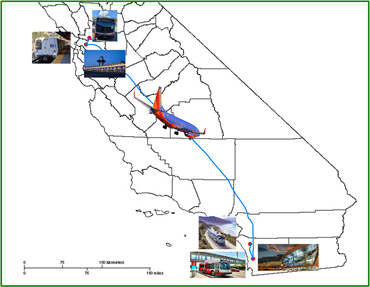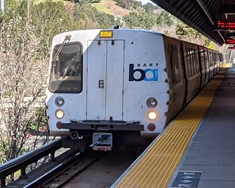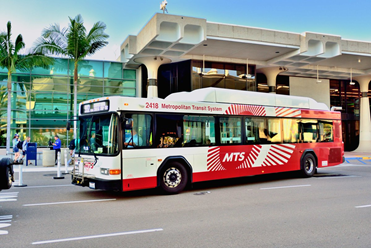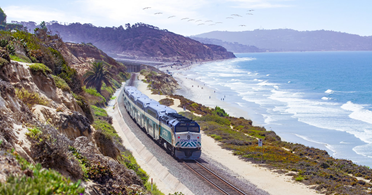Using Public Transportation for Bay Area to San Diego Trip

In the face of climate change, all of us make numerous daily choices that collectively influence the sustainability of humanity and the planet. It all starts with awareness. Pause and reflect on your daily actions. How do they impact the world? Are there changes that you could make that would better serve people and the planet?
Carbon footprint calculators from Cool Climate Network or Nature Conservancy can help with visualizing how your everyday choices impact the planet. In a recent Economist article, Chris Jones, a UC Berkeley professor who runs the Cool Climate Tracker, describes the main household polluting activities as “cars, coal, cows, and consumption,” roughly in that order. The article calls out the family vehicle as the largest single source of household emissions. EPA has also cited transportation as the largest contributor of US GHGs.
SSV Public Transportation Project
Promoting public transportation and reducing motor vehicles on the roadways is one of several Sustainable Silicon Valley focus areas. With funding from the City/County Association of Governments of San Mateo County (C/CAG), SSV is conducting a pilot project on SamTrans buses that run along University Ave. in East Palo Alto. In this pilot, buses get ‘priority’ using LYT technology. LYT is a cloud-based software platform that uses state-of-the-art connected vehicle and machine learning technologies to prioritize the flow of vehicles in a city and across a corridor.
During the iTSP pilot, if a bus approaches a green light that is about to turn red, the bus will get ‘priority’ and the light will remain green so the bus can safely flow through the intersection. This reduces bus travel time, fuel consumption and emissions. The goal is to make public transportation more attractive and a viable option.
Evolution and Rewiring Your Brain
As local and state organizations work to improve public transportation options and efficiencies, individuals need to be open minded about testing, learning, and adopting these new forms of transportation to reduce emissions as well as enjoy a host of other benefits. Change, as in retraining your brain to adopt new habits or change your everyday routine, is good for your brain health. Taking a new route or approach-walking, biking, riding public transportation- can help reduce emissions and give your brain a fun workout.
Climate change is both a natural phenomenon and a man-made one. Adapting to a changing world requires an openness to changing the way we do things in terms of being more resilient in the face of change, as well as living more sustainably and harmoniously with nature and each other.
Using Public Transportation: A Personal Travel Experiment
In the spirit of leaning into more climate friendly transportation choices and challenging my brain, I experimented with using public transportation to get to and from the airport on a recent trip from Oakland to San Diego.
In addition to reducing my motor vehicle carbon footprint (reduced gas emissions and expense), there were other benefits. There was a sense of adventure from trying something new, cost savings from not parking at the airport or renting a car, self-sufficiency, traffic avoidance, and less stress on my aging parents who otherwise would have had to drive (two ways) in commute traffic on a rainy day to pick me up.
Living in the East Bay, my journey started with catching a local County Connection bus for an eight minute ride to the BART station and then hopping on a train that arrived in approximately 13 minutes. My BART train ride included two train transfers, with about two to seven minutes between connections. This is a comfortable amount of time for an ambulatory adult towing a carryon-sized roller board bag and carrying a small backpack or less. It is not great for parents with babies in strollers or older folks who cannot walk very far or carry their bags. Total travel time to Oakland Airport was about 60 minutes versus 30-45 minutes driving, depending on traffic.

After landing in San Diego, I scooted off the plane straight to the curb, as I had carried on my roller board suitcase when boarding the plane. I caught a local San Diego Metro bus for a 10 minute ride to the Santa Fe train station in downtown San Diego. Within 20-25 minutes the NCTD Coaster train arrived, and I hopped aboard for the approximately 1 hour ride to my north county destination. Total time was about 90 minutes vs. 45-60 minutes for driving (one way), depending on traffic.


While it does take longer to travel on public transportation than driving one-way, you are essentially freeing up time for the family member or friend who kindly offered to drive you to the airport, and then back home again, which in turn cuts down on emissions. Overall, it was a good experience, and I would use public transportation again when traveling to and from the airport during the day. For early morning or late night travel, a car or some type of car service is likely to work better, albeit at a higher cost than public transportation. Increasingly, taxis and ride-hailing company drivers are reducing emissions by adopting hybrid vehicles or EVs.
Some people might criticize my airplane travel as being climate unfriendly, and they would have a fair point. However, traveling by air is better than one person driving 500 miles (each way). Additionally, I travel less than 5K airline miles per year to see my family. Nonetheless, I will work at ways to offset my airline travel emissions by using public transportation, working from home, consuming less animal protein, consolidating errands, turning down the thermostat in the winter, replacing leaky heating ducts, taking shorter showers, running full dishwasher and laundry loads during non-peak use hours, etc. When the time comes to replace vehicles and appliances, we will look for low/zero emissions options. Sustainable living is all about finding the right balance and living smarter.
Pro Tips
Here are a few suggestions to help make traveling on public transportation easier and more enjoyable:
- Check public transportation availability and schedules before booking flights. This will help minimize wait times. Based on my experience, public transportation runs more frequently during the morning and evening commute hours.
- Use Google Maps to chart your journey before booking flights, the day before departure, and while traveling. Google Maps provides information about bus/train numbers, fares, and real time updates on location, and timing.
- Go digital with payments by downloading relevant transportation phone apps or preloading transportation cards, such as Clipper Card and Pronto.
- Pack light and bring an umbrella in case of rain.
- Bring a few digital articles or a good book to read while traveling.
Riding public transportation is one of those everyday choices each person can make to help reduce emissions, make traveling more interesting, and improve your brain health. The more you do it, the easier it gets as your brain pathways rewire, and the better you feel about creating positive change for people and the planet.
Public Transportation References:
North County Transit District Coaster